
Papal Coinage
.pdf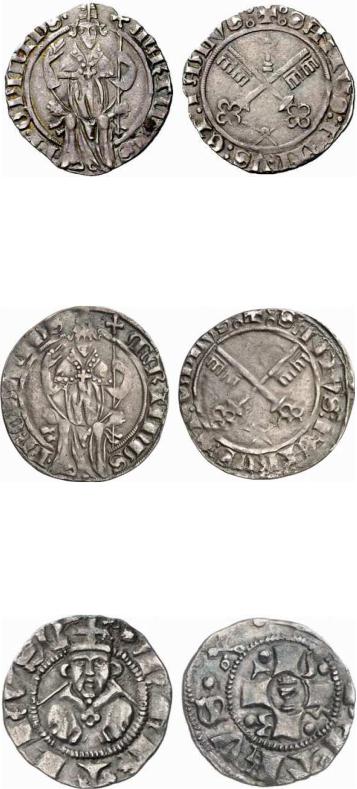
PAPAL COINS
Martin V., 1417-1431.
Grosso. Avignon mint. 26 mm 2,00 g.
Obv.: Tiara-crowned pope seated facing on throne decorated with lions heads, right hand raised in blessing, left hand with corss staff. MARTINVS PP QVINTVS
Rev.: Crossed keys, column mark above; + : SANTVS: PETRVS: ET PAVLVS:
Reference: Muntoni 33. Berman 286. Good VF.
Estimate: EUR 200. Price realized: 300 EUR (approx. 445 U.S. Dollars as of the auction date)
PAPAL COINS
Martin V., 1417-1431.
Grosso. Avignon mint. 26 mm 2,00 g.
Obv.: Tiara-crowned pope seated facing on throne decorated with lions heads, right hand raised in blessing, left hand with corss staff. MARTINVS PP QVINTVS
Rev.: Crossed keys, column mark above; + : SANTVS: PETRVS: ET PAVLVS:
Reference: Muntoni 33. Rare, VF.
Estimate: 350 EUR. Price realized: 625 EUR (approx. 958 U.S. Dollars as of the auction date)
PAPAL COINS
Martin V., 1417-1431.
Bolognino. Rome mint.
Obv.: Mitred bust facing. MARTINUS V
Rev.: U R B I arranged in cruciform; chalice in center. Balls in angles. Legend around: (crossed keys) ...PETRUS
Nice portrait, VF+
Estimate: 40 EUR. Price realized: 140 EUR (approx. 215 U.S. Dollars as of the auction date)
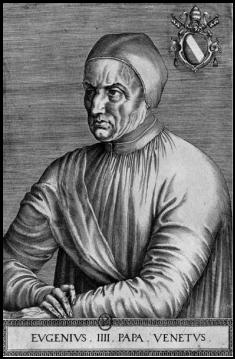
Eugenius IV - 3 March 1431 to 23 Feb. 1447
He was born in Venice to a rich merchant family, a Correr on his mother's side. Condulmer entered the Augustinian order at the monastery of St. George in his native city. At the age of twenty-four he was appointed by his uncle Pope Gregory XII (1406–15), as Bishop of Siena, and came into prominence. In Siena, the political class objected to a 24-year old bishop who was a foreigner. Therefore, the issue was not pressed, and he resigned the appointment, becoming instead his uncle's papal treasurer, protonotary, Cardinal Priest of San Marco and San Clemente, and later Cardinal Priest of Basilica di Santa Maria in Trastevere.
He made himself useful to Pope Martin V (1417–31) and was quickly elected to succeed him. Eugene was crowned as Eugene IV at St. Peter's, March 11, 1431. By a written agreement made before his election he agreed with the cardinals to distribute to them one-half of all the revenues of the Church and promised to consult with them on all questions of importance, both spiritual and temporal. Upon taking the Papal Chair, Eugene IV took violent measures against the numerous Colonna relations of his predecessor, Pope Martin V (Ottone Colonna), who had rewarded his numerous clan with castles and lands. This at once involved him in a serious contest with the powerful house of Colonna that nominally supported the local rights of Rome against the interests of the Papacy. A truce was soon arranged.
But by far the most important feature of Eugene IV's pontificate was the great struggle between the Pope and the Council of Basel, commonly referred to as the Council of Florence, (1431–39), part of the historic Conciliar movement. On July 23, 1431, his legate, Giuliano Cesarini, opened the council, which had been convoked by Martin V, but, distrustful of its purposes and emboldened by the small attendance, the pope issued a bull on December 18, 1431, dissolving the council and calling a new one to
meet in eighteen months at Bologna. The council resisted this premature expression of papal prerogative, as it appeared to the majority of them. Eugene IV's action gave some weight to the contention that the Curia was opposed to any authentic measures of reform. The council refused to dissolve; instead they renewed the resolutions by which the Council of Constance had declared a council superior to the Pope, and cited Eugene IV to appear at Basel. A compromise was arranged by Sigismund, Holy Roman Emperor, who had been crowned emperor at Rome on May 31, 1433. By its terms the Pope recalled his bull of dissolution, and, reserving all the rights of the Holy See, acknowledged the council as ecumenical (December 15, 1433). The pope agreed to name presidents to lead the council on his behalf.
These concessions also were due to the invasion of the Papal States by the former Papal condottiero Niccolò Fortebraccio and the troops of Filippo Maria Visconti led by Niccolò Piccinino, in retaliation to Eugene's support to Florence and Venice against Milan (see also Wars in Lombardy). This situation led also to establishment of an insurrectionary republic at Rome, controlled by the Colonna family. In early June, disguised in the robes of a Benedictine monk, he was rowed down the center of the Tiber, pelted by stones from either bank, to a Florentine vessel waiting to pick him up at Ostia. The city was restored to obedience by Giovanni Vitelleschi, the militant Bishop of Recanati, in the following October. In August of 1435 a peace treaty was signed at Ferrara by the various belligerents. The Pope moved to Bologna in April of 1436. His condottieri Francesco Sforza and Vitelleschi in the meantime reconquered much of the Papal States. Traditional papal enemies such as the Prefetti di Vico were destroyed, while the Colonna were reduced to obedience after the destruction of their stronghold in Palestrina (August, 1436).
Meanwhile the struggle with the council sitting at Basel broke out anew. Eugene IV at length convened a rival council at Ferrara on January 8, 1438, and excommunicated the prelates assembled at Basel. The result was that the Council of Basel suspended him on January 24, 1438, then formally deposed him as a heretic on June 25, 1439, and in the following November elected the ambitious Amadeus VIII, Duke of Savoy, antipope under the name of Felix V. The conduct of France and Germany seemed to warrant this action, for Charles VII of France had introduced the decrees of the Council of Basel, with slight changes, into France through the Pragmatic Sanction of Bourges (July 7, 1438), and the Diet of Mainz had deprived the Pope of most of his rights in the Empire (March 26, 1439).
At Florence, where the council of Ferrara had been transferred on account of an outbreak of the plague, a union with the Eastern Orthodox Church was effected in July, 1439, which, as the result of political necessities, proved but a temporary bolster to the papacy's prestige.
This union was followed by others of even less stability. Eugene IV signed an agreement with the Armenians on November 22, 1439, and with a part of the Jacobites in 1443, and in 1445 he received the Nestorians and the Maronites. He did his best to stem the Turkish advance, pledging one-fifth of the papal income to the crusade which set out in 1443, but which met with overwhelming defeat at Varna. Cardinal Cesarini, the papal legate, perished in the rout.

His rival, Felix V, meanwhile, obtained small recognition, even in the Empire. Eventually Frederick III, king of the Romans, moved toward acceptance of Eugene. The king's ablest adviser, the humanist Aeneas Sylvius Piccolomini, who was later to be Pope Pius II, made peace with Eugene IV in 1442. The Pope's recognition of the claim to Naples of King Alfonso V of Aragon (treaty of Terracina, signed by Eugene at Siena somewhat later) withdrew the last important support from the council of Basel. In 1442 Eugene, Alfonso and Visconti sent Niccolò Piccinino to reconquer the March ofAncona from Francesco Sforza, but the defeat of the allied army at the Montolmo pushed the Pope to reconcile with Sforza.
So enabled, Eugene IV made a victorious entry into Rome on 28 September 1443, after an exile of nearly ten years.
His protests against the Pragmatic Sanction of Bourges were ineffectual, but by means of the Concordat of the Princes, negotiated by Piccolomini with the electors in February, 1447, the whole of Germany declared against the antipope. This agreement was finalized only after Eugene's death.
Although his pontificate had been so stormy and unhappy that he is said to have regretted on his deathbed that he ever left his monastery, nevertheless Eugene IV's victory over the council of Basel and his efforts on behalf of church unity contributed greatly to the breakdown of the conciliar movement and restore the papacy to the dominant position it had held before the Western Schism (1378–1417).
Eugene IV was dignified in demeanour, but inexperienced and vacillating in action and excitable in temper. Bitter in his hatred of heresy, he nevertheless displayed great kindness to the poor. He laboured to reform the monastic orders, especially the Franciscans, and was never guilty of nepotism. Although austere in his private life, he was a sincere friend of art and learning, and in 1431 he re-established the university at Rome. Eugene was buried at Saint Peter's by the tomb of Pope Eugene III, the former pupil of Bernard of Clairvaux.Later his tomb was transferred in San Salvatore in Lauro-a parish church on the other bank of the Tiber river.
Eugene IV was against the enslavement of natives from the Canary Islands: in January 13, 1435, at Florence, Eugene enacted the Papal Bull "Sicut Dudum" about the enslaving by Spanish slave trader. The Pope wrote: ".... These people are to be totally and perpetually free, and are to be let go without the exaction or reception of money"... But the Spanish didn't listen to the Pope and asserted that the natives weren't men but a sort of animal.
PAPAL COINS |
PAPAL COINS |
Eugenius IV., 1431-1447. |
Eugenius IV., 1431-1447. |
Ducato. Rome mint. 3,34 g. |
Ducato. Rome mint. 23 mm 3,51 g. |
Obv.: ·EVGENIVS ·PP·QVARTVS · Papal tiara and crossed keys over coat-of-arms in quatra-lobe.
Rev.: ·S ·PETRVS ·- ALMA·ROMA· Nimbate St. Peter stands facing with key and book, all in quatralobe.
Rim damage. VF-XF.
Estimate: 1000 EUR. Price realized: 1,200 EUR (approx. 1,839 U.S. Dollars as of the auction date)
Obv.: ·EVGENIVS ·PP·QVARTVS · Papal tiara and crossed keys over coat-of-arms in quatra-lobe.
Rev.: ·S ·PETRVS ·- ALMA·ROMA· Nimbate St. Peter stands facing with key and book, all in quatralobe.
Reference: CNI 1. Muntoni 1. Berman 300. Friedberg 3. Rare. XF.
Estimate: EUR 1800. Price realized: 1,800 EUR (approx. 2,398 U.S. Dollars as of the auction date)

PAPAL COINS
Eugenius IV., 1431-1447.
Ducato. Rome mint. 22 mm 3,46 g.
Obv.: ·EVGENIVS ·PP·QVARTVS · Papal tiara and crossed keys over coat-of-arms in quatra-lobe.
Rev.: ·S ·PETRVS ·- ALMA·ROMA· Nimbate St. Peter stands facing with key and book, all in quatralobe.
Reference: Muntoni 2; Fr. 3a. GOLD. Slight rim damage, VF.
Estimate CHF 500. Price realized: 750 CHF (approx. 589 U.S. Dollars as of the auction date)
PAPAL COINS
Eugenius IV., 1431-1447.
Ducato. Rome mint. 3,49 g.
Obv.: ·+EVGENIVS ·PP·QVARTVS · Papal tiara and crossed keys over coat-of-arms in quatra-lobe.
Rev.: ·+S ·PETRVS ·- ALMA·ROMA· Nimbate St. Peter stands facing with key and book, all in quatralobe.
Reference: 3,49 g. Fb. 3 a; Muntoni 3. GOLD. VF.
Estimate: 800 EUR. Price realized: 900 EUR (approx. 1,142 U.S. Dollars as of the auction date)
PAPAL COINS
Eugenius IV., 1431-1447.
Ducato. Rome mint. 24 mm 3,51 g.
Obv.: ·EVGENIVS ·PP·QVARTVS · Papal tiara and crossed keys over coat-of-arms, in pearled circle.
Rev.: ·S ·PETRVS ·- ALMA·ROMA· Nimbate St. Peter stands facing with key and book, in pearled circle.
Reference: CNI 5. Muntoni 2. Berman 301. Friedberg 3. Rare. XF.
Estimate: EUR 1200. Price realized: 3,600 EUR (approx. 4,797 U.S. Dollars as of the auction date)
PAPAL COINS
Eugenius IV., 1431-1447.
Ducato. Rome mint. 3,49 g.
Obv.: ·+EVGENIVS ·PP·QVARTVS · Papal tiara and crossed keys over coat-of-arms in quatra-lobe. Rosette divider.
Rev.: ·+S ·PETRVS ·- ALMA·ROMA· Nimbate St. Peter stands facing with key and book, all in quatralobe.
Reference: CNI.3. Munt.4. F.3a. VF.
Estimate: FRF 5000. Price realized: 4,250 FRF (approx. 578 U.S. Dollars as of the auction date)
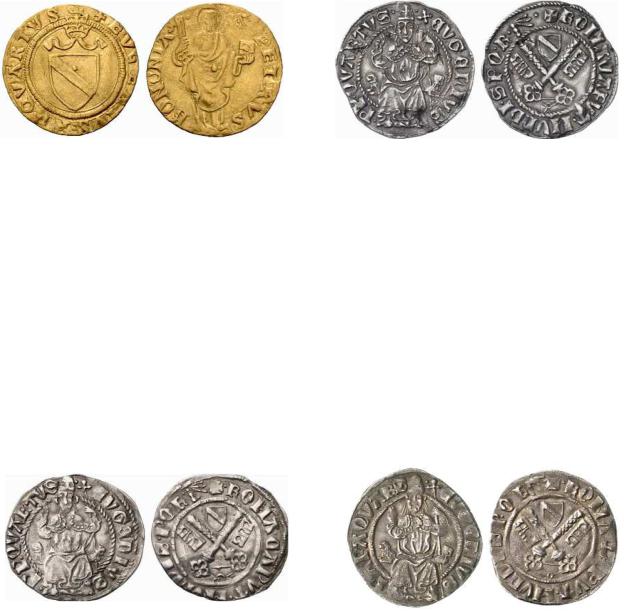
PAPAL COINS
Eugenius IV., 1431-1447.
Ducato. Bologna mint. 22 mm 3,43 g.
Obv.: ·EVGENIVS ·PP·QVARTVS · Papal tiara and crossed keys over coat-of-arms, in rope circle.
Rev.: ·S ·PETRVS ·-BONONIA· Nimbate St. Peter stands facing with key and book, in rope circle.
Reference: CNI 1. Munt. 30. Berman 312. Frd. 323. Ver rare. Beautiful!
Estimate: EUR 700. Price realized: 1,800 EUR (approx. 2,398 U.S. Dollars as of the auction date)
PAPAL COINS
Eugenius IV., 1431-1447.
Grosso. Rome mint.
Obv.: Tiara-crowned pope seated facing on throne decorated with lions heads, right hand raised in blessing, left hand with corss staff. EVGENIVS ·PP ·QVARTVS
Rev.: Crossed keys, coat of arms above; + ROMA CAPVT MVNDI SPQR
Reference: Biaggi 2152 (R2); Muntoni 8. Very rare, VF.
Estimate: 1250 EUR.
PAPAL COINS
Eugenius IV., 1431-1447.
Grosso. Rome mint.
Obv.: Tiara-crowned pope seated facing on throne decorated with lions heads, right hand raised in blessing, left hand with corss staff. EVGENIVS ·PP ·QVARTVS
Rev.: Crossed keys, coat of arms above; + ROMA CAPVT MVNDI SPQR
Beautiful dark toning, rim damage, small hole. Still VF-XF.
Estimate: 400 EUR. Price realized: 700 EUR (approx. 1,073 U.S. Dollars as of the auction date)
PAPAL COINS
Eugenius IV., 1431-1447.
Grosso. Rome mint. 3,84 g.
Obv.: Tiara-crowned pope seated facing on throne decorated with lions heads, right hand raised in blessing, left hand with corss staff. EVGENIVS ·PAPA ·QVARS
Rev.: Crossed keys, coat of arms above; + ROMA CAPVT MVNDI SPQR
Reference: Muntoni 8 Var. II. Very rare. Nice Patina, VF.
Estimate: 300.00 EUR. Price realized: 600 EUR (approx. 720 U.S. Dollars as of the auction date
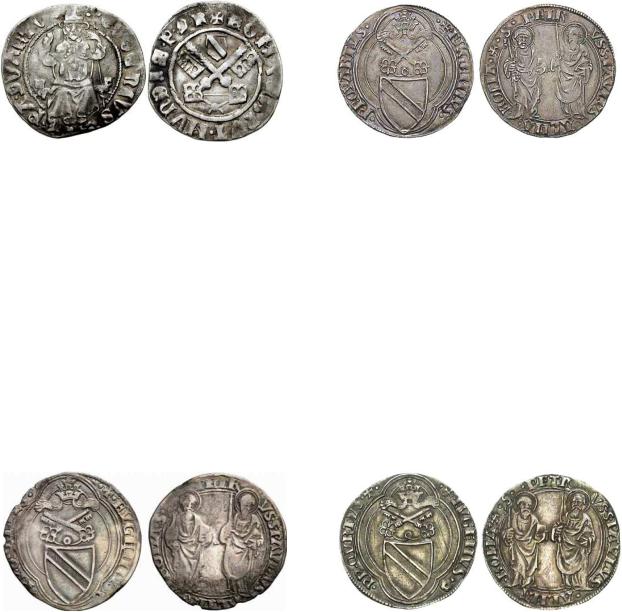
PAPAL COINS
Eugenius IV., 1431-1447.
Grosso. Rome mint. 3,80 g.
Obv.: Tiara-crowned pope seated facing on throne decorated with lions heads, right hand raised in blessing, left hand with corss staff. EVGENIVS ·PA ·QVARTVS
Rev.: Crossed keys, coat of arms above; + ROMA CAPVT MVNDI SPQR
Reference: CNI XV pg. 223, 34; cf. Muntoni I pg. 47, 13; Berman 303. VF, warped flan.
Estimate $400. Price realized: 400 USD
PAPAL COINS
Eugenius IV., 1431-1447.
Grosso. Rome mint.
Obv.: Condulmer coat-of-arms surmounted by tiara and keys, all within quadrilobe +EVGENIVS• PP QVARTVS•
Rev.: + •S• PETR VS •S• P AVLVS •ALMA• ROMA•, Nimbate S t. Peter and St. Paul standing, holding swords and books.
Reference:Biaggi 2155 (R2); Muntoni 19. Very rare. F-VF.
Estimate: 100 EUR. Price realized: 150 EUR (approx. 230 U.S. Dollars as of the auction date)
PAPAL COINS
Eugenius IV., 1431-1447.
Grosso. Rome mint. 3,92 g.
Obv.: Condulmer coat-of-arms surmounted by tiara and keys, all within quadrilobe +EVGENIVS• PP QVARTVS•
Rev.: + •S• PETR VS •S• P AVLVS •ALMA• ROMA•, Nimbate S t. Peter and St. Paul standing, holding swords and books.
Reference: Muntoni I pg. 47, 17; CNI XV pg. 229, 43; Berman 305. Good VF, very attractive.
Estimate $400. Price realized: 658 USD
PAPAL COINS
Eugenius IV., 1431-1447.
Grosso. Rome mint.
Obv.: Condulmer coat-of-arms surmounted by tiara and keys, all within quadrilobe +EVGENVS(rosette) PP QVARTVS+
Rev.: +·S· PETR-VS ·S· PAVLVS- ·ALMA·- ROMA· , Nimbate St. Peter and St. Paul standing, holding swords and books.
Reference: Munt., 19 var; Berman, 306. 3,91g. Rare. Beautiful patina. - VF - EF.
Estimate: EUR 600. Price realized: 1,100 EUR (approx. 1,384 U.S. Dollars as of the auction date)
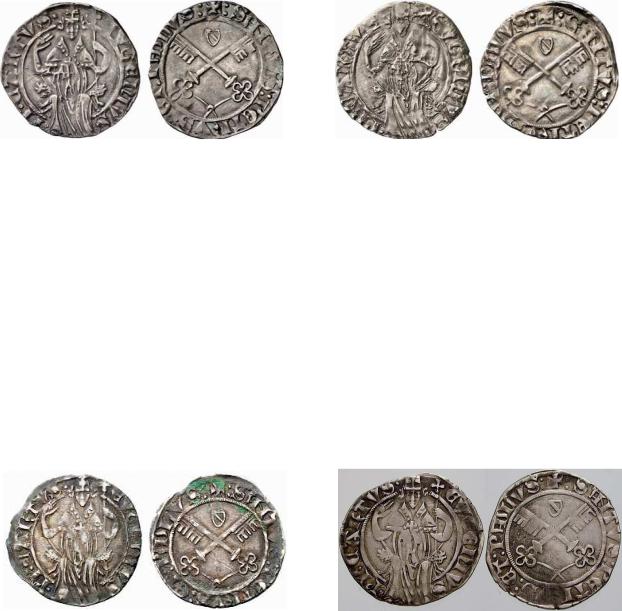
PAPAL COINS
Eugenius IV., 1431-1447.
Carlino. Avignon. mint.
Obv.: Tiara-crowned pope seated facing on throne decorated with lions heads, right hand raised in blessing, left hand with corss staff. EVGENIVS ·PP ·QVARTVS
Rev.: Crossed keys, coat of arms above; + SANTVS PETRVS ET PAVLVS
Beautiful toning, VF+.
Estimate: 200 EUR. Price realized: 480 EUR (approx. 736 U.S. Dollars as of the auction date)
PAPAL COINS
Eugenius IV., 1431-1447.
Carlino. Avignon. mint. 26 mm 2,00 g.
Obv.: Tiara-crowned pope seated facing on throne decorated with lions heads, right hand raised in blessing, left hand with corss staff. EVGENIVS ·PP ·QVARTVS
Rev.: Crossed keys, coat of arms above; + SANTVS PETRVS ET PAVLVS
Reference: Muntoni 27. Berman 319. VF.
Estimate: EUR 200. Price realized: 380 EUR (approx. 564 U.S. Dollars as of the auction date)
PAPAL COINS
Eugenius IV., 1431-1447.
Carlino. Avignon. mint.
Obv.: Tiara-crowned pope seated facing on throne decorated with lions heads, right hand raised in blessing, left hand with corss staff. EVGENIVS ·PP ·QVARTVS
Rev.: Crossed keys, coat of arms above; + SANTVS PETRVS ET PAVLVS
Reference: Muntoni 27. Rare, VF.
Estimate: 300 EUR. Price realized: 240 EUR (approx. 368 U.S. Dollars as of the auction date)
PAPAL COINS
Eugenius IV., 1431-1447.
Carlino. Avignon. mint. 2,08 g.
Obv.: Tiara-crowned pope seated facing on throne decorated with lions heads, right hand raised in blessing, left hand with corss staff. EVGENIVS ·PP ·QVARTVS
Rev.: Crossed keys, coat of arms above; + SANTVS PETRVS ET PAVLVS
Reference: Berman 319; Muntoni 27; Poey d’Avant 4245-4246. VF.
Estimation DM 450. Price realized: 625 DEM (approx. 284 U.S. Dollars as of the auction date)
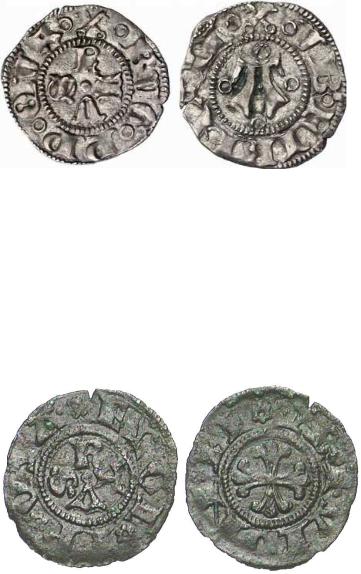
PAPAL COINS
Eugenius IV., 1431-1447.
Bolognino. Fermo.
Obv.: (Crossed keys)EVG PP QVA Ringlet dividers; around 4 letters arranged in cruciform, in pearled circle.
Rev.: “A” monogram, ringlet flanking 4 sides; in pearled circle. Legend around.
VF+
Estimate: 30 EUR. Price realized: 110 EUR (approx. 169 U.S. Dollars as of the auction date)
PAPAL COINS
Eugenius IV., 1431-1447.
Cu picciolo. Foligno mint. 0,55 g.
Obv.: EVGE PP QVA around R-T-V-S arranged in cruciform, in pearled circle.
Rev.: VB FVLGNEI Floreate cross in pearled circle. Rosette dividers.
Reference: Munt., 41 var; Berman, 318 var. Rare. Nice dark patina. VF.
Estimate: EUR 275. Price realized: 220 EUR (approx. 316 U.S. Dollars as of the auction date)
Nicholas V - 6 March 1447 - 24 March 1455
Nicholas V (Italian: Niccolò V; November 15, 1397 – March 24, 1455), born Tommaso Parentucelli, was Pope from March 6, 1447 to his death in 1455.
He was born at Sarzana, Liguria, where his father was a physician. His father died while he was young, but in Florence, Parentucelli became a tutor in the families of the Strozzi and Albizzi, where he made the acquaintance of the leading humanist scholars. He studied at Bologna, gaining a degree in theology in 1422, whereupon the bishop, NiccolòAlbergati, was so much struck with his capacities that he took him into his service and gave him the chance to pursue his studies further, by sending him on a tour through Germany, France and England. He was able to collect books, for which he had an intellectual's passion, wherever he went. Some of them survive, with his marginal annotations.
He distinguished himself at the Council of Florence, and in 1444, when his patron died, he was appointed bishop of Bologna in his place. Civic disorders at Bologna were prolonged, so Pope Eugene IV (1431–1447) soon named him as one of the legates sent to Frankfurt to negotiate an understanding between the Papal States and the Holy Roman Empire, with regard to undercutting or at least containing the reforming decrees of the Council of Basel (1431–1439). His successful diplomacy gained him the reward, on his return to Rome, of the title of Cardinal priest of Santa Susanna (December 1446). He was elected Pope in succession to Eugene IV on 6 March of the following year, taking the name of Nicholas V in honour of his early benefactor.
The eight scant years of his pontificate (1447–1455) were important in the political, scientific and literary history of the world. Politically, he made the Concordat of Vienna, or Aschaffenburg (February 17, 1448) with the German King, Frederick III (1440–1493), by which the decrees of the Council of Basel against papal annates and reservations were abrogated so far as Germany was concerned; and in the following year he secured a still greater tactical triumph, when the resignation of the antipope Felix V (1439–1449) (7 April) and his own recognition by the rump of the council of Basel (1431–39), assembled at Lausanne, put an end to the Western Schism (1378–1417). The next year, 1450, Nicholas V held a Jubilee at Rome; and the offerings of the numerous pilgrims who thronged to Rome gave him the means of furthering the cause of culture in Italy, which he had so much at heart. In March 1452 he crowned Frederick III as Emperor in St. Peter's, the last occasion of the coronation of an Emperor at Rome.
Within the city of Rome, Nicholas V introduced the fresh spirit of the Renaissance. His plans were of embellishing the city with new monuments worthy of the capital of the Christian world. His first care was practical, to reinforce the city's fortifications, cleaning and even paving some main streets and restoring the water supply. The end of ancient Rome is sometimes dated from the destruction of its magnificent array of aqueducts by 6th century invaders. In the Middle Ages Romans depended for water on wells and cisterns, and the poor dipped their water from the yellow Tiber. The Aqua Virgo aqueduct, originally constructed by Agrippa, was restored by Pope Nicholas V, and emptied into a simple basin that Leon Battista Alberti designed, the predecessor of the Trevi Fountain.
But the works on which he especially set his heart were the rebuilding of the Vatican and the Borgo district, and St Peter's Basilica, where the reborn glories of the papacy were to be focused. He got as far as pulling down part of the ancient basilica, made some alterations to the Lateran Palace (of which some frescos by Fra Angelico bear witness), and laid up 2,522 cartloads of marble from the dilapidated Colosseum for use in the later constructions.
Under the generous patronage of Nicholas V, humanism made rapid strides as well. The new humanist learning had been looked on with suspicion in Rome, a possible source of schism and heresy, an unhealthy interest in paganism. Nicholas V instead employed Lorenzo Valla as a notary and kept hundreds[dubious – discuss] of copyists and scholars, with the special aim of wholesale translations of Greek works, pagan as well as Christian, into Latin, giving as much as ten thousand gulden for a metrical translation of Homer. This industry, coming just before the dawn of printing, contributed enormously to the sudden expansion of the intellectual horizon. Nicholas V founded a library of nine thousand volumes. The Pope himself was a man of vast erudition, and his friend Aeneas Silvius Piccolomini, later Pope Pius II (1458–1464), said of him that "what he does not know is outside the range of human knowledge".
In 1452, Nicholas V issued the papal bull Dum Diversas, granting the king of Portugal the right to reduce any "Saracens, pagans and any other unbelievers" to hereditary slavery. Dum Diversas legitimised the colonial slave trade that begun around this time with the expeditions by Henry the Navigator to find a sea route to India, which were financed with African slaves. This approval of slavery was reaffirmed and extended in his Romanus Pontifex of 1455.
He was compelled, however, to add that the lustre of his pontificate would be forever dulled by the fall of Constantinople, which the Turks took in 1453. The Pope bitterly felt this catastrophe as a double blow to Christendom and to Greek letters. "It is a second death," wrote Aeneas Silvius, "to Homer and Plato". Nicholas V preached a crusade, and endeavoured to reconcile the mutual animosities of the Italian states, but without much success. He did not live long enough to see the effect of the Greek scholars armed with unimagined manuscripts, who began to find their way to Italy.
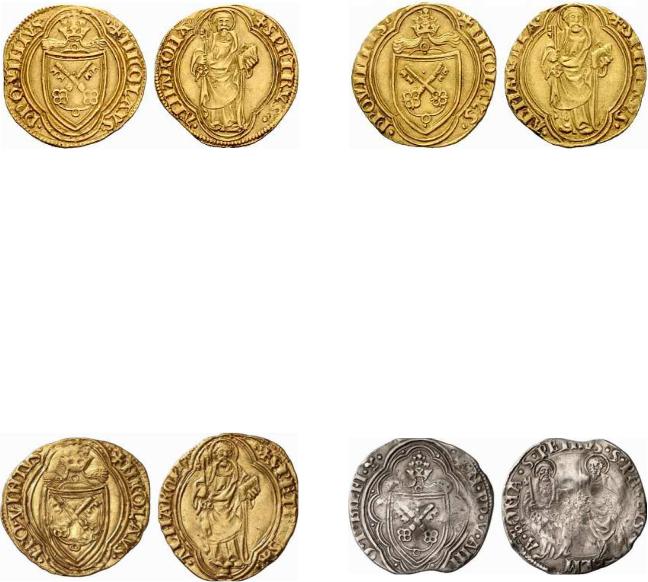
In undertaking these works Nicholas V was moved "to strengthen the weak faith of the populace by the greatness of that which it sees". The Roman populace, however, appreciated neither his motives nor their results, and in 1452 a formidable conspiracy for the overthrow of the papal government, under the leadership of Stefano Porcaro, was discovered and crushed. This revelation of disaffection, together with the fall of Constantinople in 1453, darkened the last years of Pope Nicholas V; "As Thomas of Sarzana," he said, "I had more happiness in a day than now in a whole year".
PAPAL COINS
Nicolas V., 1447-1455.
Ducato. Rome mint. 23 mm 3.54 g
Obv.: + NICOLAVS PP QVINTVS Papal tiara-crowned coat of arms with crossed keys, in quadralobe.
Rev.: S PETRVS ALMA ROMA Nimbate St. Peter stands facing, holding key and book.
Reference:. Muntoni 4; Fr. 6. aXF.
Estimate CHF 2500. Price realized: 2,000 CHF (approx. 1,705 U.S. Dollars as of the auction date)
PAPAL COINS
Nicolas V., 1447-1455.
Ducato. Rome mint. 23 mm 3.50 g
Obv.: + NICOLAVS PP QVINTVS Papal tiara-crowned coat of arms with crossed keys, in quadralobe.
Rev.: S PETRVS ALMA ROMA Nimbate St. Peter stands facing, holding key and book.
Reference: Fb. 6; Muntoni 5. GOLD. VF-XF.
Estimate: 750 EUR. Price realized: 1,400 EUR (approx. 2,146 U.S. Dollars as of the auction date)
PAPAL COINS
Nicolas V., 1447-1455.
Ducato. Rome mint. 23 mm 3.47 g
Obv.: + NICOLAVS PP QVINTVS Papal tiara-crowned coat of arms with crossed keys, in quadralobe.
Rev.: S PETRVS ALMA ROMA Nimbate St. Peter stands facing, holding key and book.
Reference: CNI 3. Muntoni 4. Berman 326. Friedberg 6. VF.
Estimate: EUR 550. Price realized: 800 EUR (approx. 1,187 U.S. Dollars as of the auction date)
PAPAL COINS
Nicolas V., 1447-1455.
Grosso. Rome mint. jUBILEE YEAR (1450)
Obv.: N PP V ANNO IVBILEI Papal tiara-crowned coat of arms with crossed keys, in quadralobe.
Rev.: Nimbate St. Peter (with key and book) and St. Paul (with sword) facing, looking slightly toward each other. .S. PETRVS. S. PAVLVS [.....] A ROMA
Reference: Biaggi 2163 (R3); Muntoni 10. Very rare. F.
Estimate: 100 EUR. Price realized: 190 EUR (approx. 291 U.S. Dollars as of the auction date)
